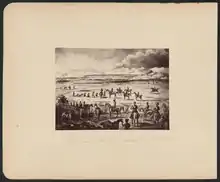Kurram Valley Field Force
The Kurram Valley Field Force were the only British troops in Afghanistan when the second phase of the Second Afghan War was set in motion by the murder of Cavagnari and his staff at Kabul on September 3, 1879. They were speedily reinforced by new units and ordered to advance on Kabul with the objective of restoring Abdur Rahman Khan to the throne.[1]

Sir Frederick Roberts led the Kabul Field Force over the Shutargardan Pass into central Afghanistan with twenty field guns and 7,500 men, including infantry, cavalry, artillery, and sappers and miners. Roberts's force moved up the Kurram Valley, winning various skirmishes and receiving envoys from Ayub Khan denying responsibility for the murders.[1]
By the beginning of October the force was at Char Asiab, twelve miles from Kabul, where 8,000 Afghans were dug in. The Afghan Army was defeated at Char Asiab on 6 October 1879. The subsequent capture of Kabul on 13 October was described by Howard Hensman, correspondent of the Daily News of London.[1]
On 11 November, a fall of snow caused the death of some of the force's elephants.[2] By mid-November, the Force was divided into two Divisions, the first at and around Kabul, the 2nd on the Khyber line. The 1st Division contained 100 British Army officers and 2,783 other ranks, plus 71 Indian Army officers and 5,060 other ranks; while the 2nd Division contained 90 British Army officers and 2,385 other ranks, plus 118 Indian Army officers and 8,590 other ranks.[3]
In December 1879, 10,000 Afghans rose against the invaders, but Roberts was well prepared and was victorious at the Battle of Sherpur.[1] In an action at Killa Kazi on 11 December 1879, James Adams, a chaplain to the Force, rescued some men of the 9th Lancers from a ditch while under enemy fire, for which he was later awarded the Victoria Cross.[4]
The Kabul Field Force was succeeded by the Kabul-Kandahar Field Force, formed in August 1880 for the march on Kandahar.[5]
See also
References
- Robert Wilkinson-Latham, North-West Frontier, 1837-1947, pp. 15-16 online
- Field Marshal Roberts, Forty-one Years in India: from Subaltern to Commander-in-chief, p. 426 online
- Roberts, op. cit., p. 427
- "No. 25008". The London Gazette. 26 August 1881. p. 4393.
- Harold E. Raugh, The Victorians at war, 1815-1914: an encyclopedia of British military history, p. 198 online